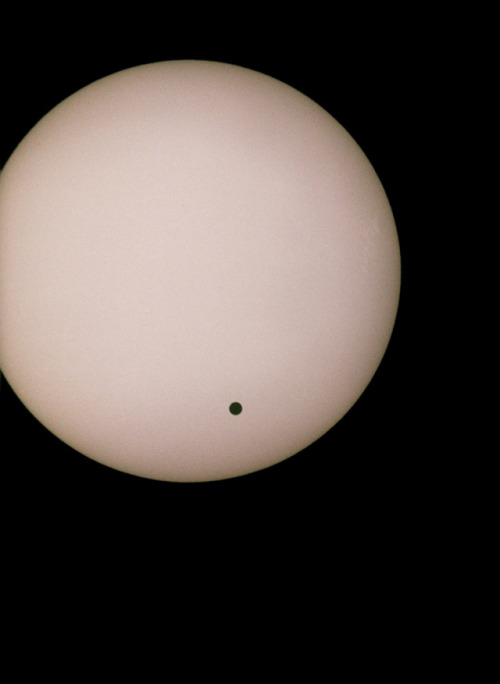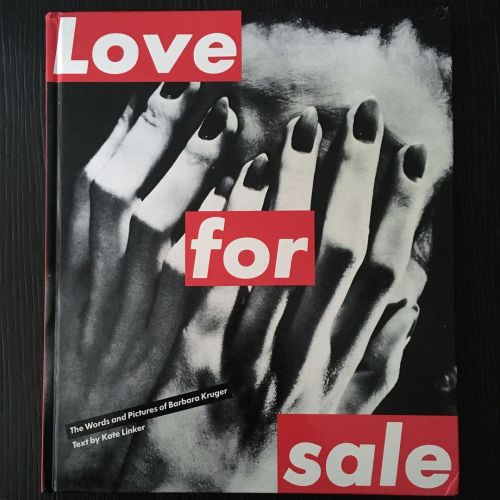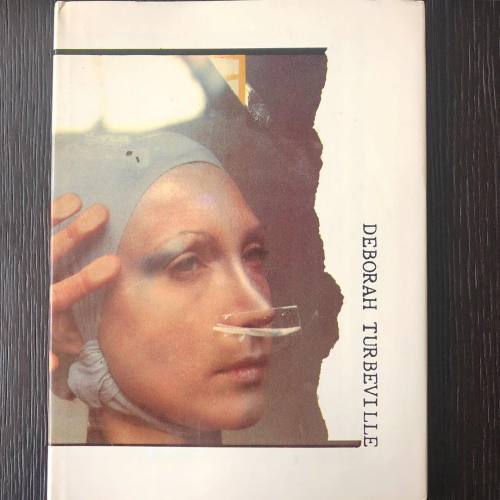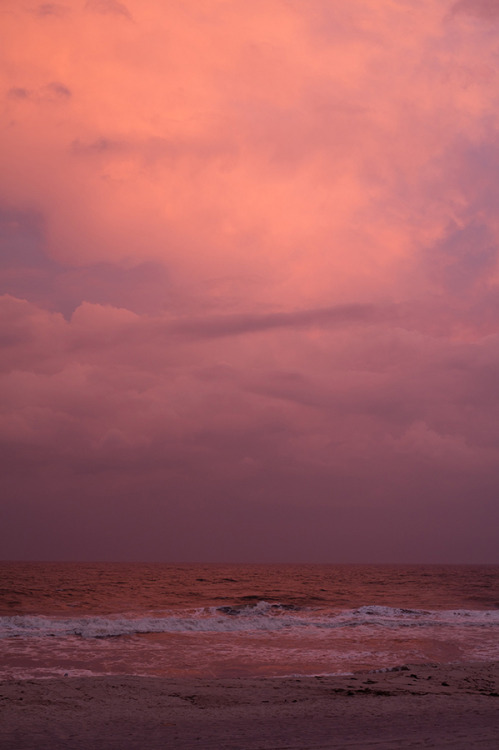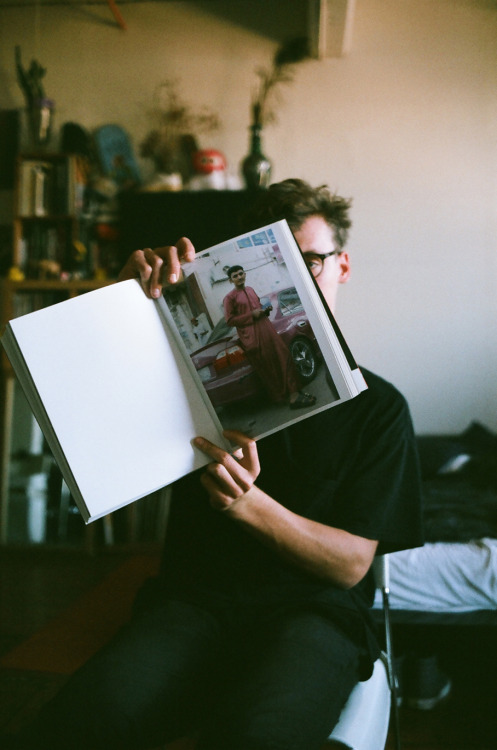#wolfgang tillmans

“Dev Hynes records his music with the windows open. You can hear the dulled urgency of a siren and the promise of more sirens. You can hear the neighbours. An errant screech. Ghosts and those who came before. A mother. Sweet greetings and voices chatting about the day’s complaints. Or the way a woman’s inflection – when she’s among her women – warms, gets real, plots, and receives affection. How her laugh means, “I love you.” You can hear pavement; chronic, comic car horns. You can hear a basketball; it sounds like a bass drum that sounds like a basketball, and so on. You can hear a saxophone; how solo and unescorted the saxophone sounds. Its noise, like loneliness next door. Its noise, like companionship just next door. What is it about saxophones that make them sound like fire escapes?
You can hear the city in the summer, at dusk. Because you can hear that, too – heat that won’t relent even as the sun begins to set. The echoing rhythm of whatever thoughts we keep to ourselves, competing with thick, thick air. You can hear muffled bass, confined to a car. The way some songs sound especially – the most – familiar when they are once removed. When you encounter them through a car pulled up to a red light. The way bass awakens us to the tension we hold in our chests. Or the joy that can spring from it, too.”
First post in forever. For the past few years, I’ve been sharing my art books collection on instagram. I collect everything from photobooks to monographs, artists’ books to zines, catalogues to big fashion books and every little weird thing in between.
I’ll probably share some more on here as well, but if that sounds like something you’d like, here is my IG page
Post link

Wolfgang Tillmans

Wolfgang Tillmans, Venus Transit, 2004.
The small black disc was Venus crossing the sun on June 8, 2004 – the first time any human then alive could have witnessed such an event.
BY SANNE KABALT
How and why did you become a photographer?
ELISE SCHOUMAN - (ES) As long as I can remember I have been working on different things. I made paintings, bags from recycled material, poems and things like tables and closets. Somewhere around my tenth birthday I started to make photographs. An analog camera was my birthday present and that was the start for me to see everything with a different view, to frame the world and focus on little things such as differences in light and shadow. I never thought that I would become an artist or photographer. I always wanted to be somebody who can change the world; I wanted to do something good for the world. So I started to study social work. After two years and lots of frustration I made the choice to change my study. I think it is the best choice of my life to have studied at the art academy.
Tell us about your educational path. What are your best memories of your studies? What was your relationship with photography at that time?
ES - My best memories are of the moments when we talked about photography, about the image itself. And it was great to make lots of work, often in a short period of time. The students around me made me focus on photography only. The important thing is that you have enough ideas and the spirit to improve yourself and to try to find the best in yourself.
Recently I’ve been thinking a lot about going to school again, following a new course and learning new things to get better at what I do and get more responses from other people, more critical opinions, more of everything.
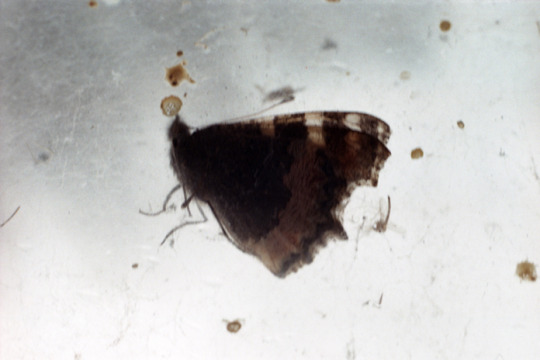
© Elise Schouman, from the series ‘Nothing is made to last forever’, dried butterfly 2012
Is there any teacher or fellow artist that has allowed you to better understand your work?
ES - Artist and teacher Petra Stavast was a very important person for me during my time at the academy, she made me look at my work in a critical way. Another teacher and also a great artist, Jan Adriaans, helped me to learn to create chaos and to explore my own limits. From that chaos I found a new starting point, a blank slate for me as an artist. This has brought me to many discoveries.
How would you describe your work in general? What kind of photographer are you?
ES - I am a maker, a creator. It always starts with little things, for example a shadow, a frown on somebody’s face. Words that I read in books or just see on the way back home. This can all trigger a story, or a thought to make something with. The story starts with a reaction and slowly I will build the walls and frames of a new work. I am an observer. I’m trying to understand the things around me. I’m trying to confuse the things around me. My photographs are poetic. The last few years I’ve been dealing with questions on finiteness and infinity. I really like the transience of things. Things will get ruined; white paper will get yellow in the sun after a while. And there is also an attraction to nature in my photographs; the overwhelming power of nature is something that affects me.
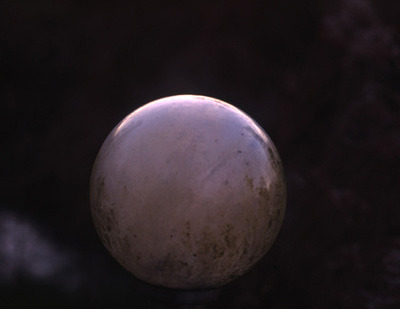

© Elise Schouman, from the series ‘Verdicht’ (‘Fiction’), 2014
When I look at your work a quick summary of what I see would be: humans relating to nature. Is it your aim to make the viewer think about this relationship?
ES - The relationship between men and nature is exiting for me; there is something dishonest to it. Humans think they are smarter than everything else on earth, but I think this isn’t true. This thought is present in my work, but I wouldn’t want to impose this on the viewer.
Lately I was thinking; what if the universe decided that men destroys and poisons their planet. Then the universe reacts with natural disasters to show men their rightful place within the universe. I feel very connected to nature. It gives me a very magical and safe feeling. A tree will be never the same; the air is the energy that gives me most ideas.
Your work has always been poetic. In recent years you have also started to write poems and combine words with images. Can you tell us about this development and how it works for you?
ES - By writing I get the feeling that I can give my thoughts a home. Since I was young I have been writing in diaries and writing little poems. For a long time I did all this writing only for myself, which is what you do with a diary; it was just a way to order my thoughts. At the moment it takes up more space in my work as an artist. I combine image with text and investigate their relation with each other.
On the sky terrace calls the cuckoo
Distant streams rustle without interruptionOn the edges, pious berries go astray
They will always find waterHigh, along the ravine, white wolves are running
Where they live, you’ll never comeThey find their way through the pure land
In the meters tall trees, the wind sighs.Elise Schouman, Borsec, May 2014

© Elise Schouman, from the series ‘Vergeet betekenis’ (‘Forgot meaning’), 2011
In your poems and texts you often suggest what we see is not real, an imagined reality. Would you prefer the viewer to see your work as truth or as fiction?
ES - I think there is no real truth, which also means that everything is the truth, or could be. The same goes for my photography; it is not the truth but it could be the truth. For me it is often the truth, and perhaps some people who read the poems may find the truth there.
I always try to get a better grip on what I actually write. Something that began with just a couple of words, with a very small idea or only just one image, grows to something bigger. By gathering information, texts and images, you create a fertile soil where beautiful things can sprout.
You have made a body of work during a residency in Borsec, Romania. Can you tell us about the residency and your work there?
ES - A place, a beautiful place deep in the forests nestled between the mountains of Romania, that provides space for artists and writers to work. I spent two weeks there, walking through the woods, climbing the mountains. I had an encounter there. An encounter with myself, with nature and with the people who were not there, but who’s absence was visibly present. This encounter I photographed. The beginning of the unknown.

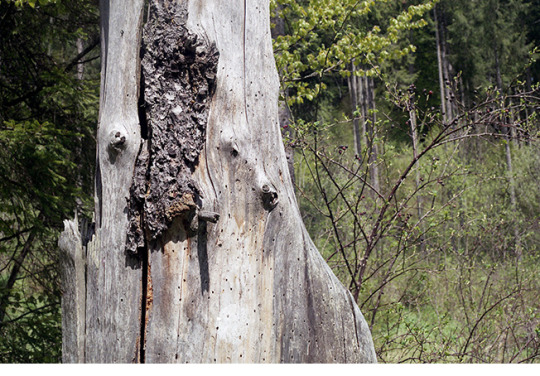

© Elise Schouman, from the series ‘An encounter’, 2014
Can you give us an insight in your day-to-day working life? Do you spend most of your time in your studio or out photographing or doing other things? Do you have any rituals that help you to be creative and productive?
Every week I have three days to work on my photography, writing and so on. These days I like to start early, first with everything that has to be done on the computer, like writing, contacts and photo editing. In the course of the day I go out and I walk often, or I take the bike and I let the wind order all my thoughts, until everything has a place. Then I come back and usually write. Ideas often come through movement, by looking, by forgetting that you want to think of something; that brings out the best ideas.
In your opinion, what is the hardest part about being a photographer? And what is the best part?
The best thing is that you get the possibility to develop your creative mind. From there you can create whatever you want. It is important to make time to empty your mind in order to create. This, for me, is freedom.
The hardest thing is that what you create is really personal. To show the depths of your inner being can be quite scary, like being naked on a stage. But I think when you show your work to the world and people have an opinion about it, it also learns you to grow as an artist.
Can you recommend a book, movie or exhibition that has been a source of inspiration to you?
The movie ‘De Zee die Denkt’ (The Sea that Thinks), is one of the best movies I have seen. The film revolves around the question ‘who are you?’; a really interesting question with more depth than it seems at first. Also the narrow bridge between what is real and what is illusion makes you look at the world slight differently.
Poems by Fernando Pessoa are a great inspiration for me.
Artists Wolfgang Tillmans and Gerard Richter are artists who made a great impression on me. I recently saw their work in an exhibition in Weserburg, a museum for modern art in Bremen. The title of the exhibition was ‘Land in sicht’, it was a really good combination of different artists. It was all about landscape, in a realistic way and also in a really abstract way. It was a great inspiration for me because of the tension between nature and the artist, between nature and the way you look at nature.
What projects are you currently working on and what are your plans for the future?
At the moment I am starting a project tilted ‘A Dream’. The dream is a window through which you can take a look into another world that in the normal waking consciousness is not accessible. In the future I want to write even more, to try to get better at it. Maybe someday I will write a book. I am always busy with little projects, such as a self-built camera, which sometimes grow into bigger projects. That’s what I like to do best.
BY LINA MANOUSOGIANNAKI
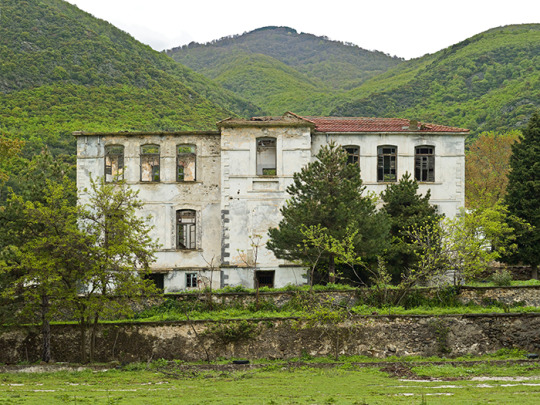
© Christoforos Doulgeris from the series ‘The School Project’
Why photography?
Christoforos Doulgeris (CD) - Photography became part of my life in an early age. My family had just moved to Dusseldorf and while attending high school I started following, fanatically, the exhibitions of the Museum of Modern Art of the city. This habit became an action and I discovered in this particular medium of expression a personal space which could express my own interpretation of reality. Photography had thus become a space in which I could create images. It actually replaced my first love, the cinema. However, my study on cinema and cinematography helped me transfer to “my” photography an internal tension which gradually started being part of a reasoning. The evolution and the perfection of this reasoning came with time elapsed. Until today I judge my images with the same criterion: complete freedom and peace at heart!
What did actually push you to choose the photographic practice as your medium of artistic expression?
CD - The reason for which I have chosen the medium of photography is that of straightness. It is the idea of a form of art which provokes the imagination and has countless ways of seducing. I would say that it is the power of creating a small dream, as well as a magical image, that drew me to photography. I work with ideas which are quite realistic but do present a concrete, tectonic side, usually expressed through architecture or sculpture.
When did it all start? Tell us a bit about the beginning of your photographic work.
I was only thirteen when I realised that I could be making images that would have an importance, a kind of sentimental value for me. So, I started making portraits in my immediate circle, family and university mates, and eventually developed my technique. The idea always preserved in my head was that the more an image is original the more the image would have an importance to me personally. For me aesthetics and philosophy of the image have always been a priority.

© Christoforos Doulgeris from the series ‘The School Project’
Henri Cartier-Bresson declared: «Your first 10000 photographs are your worst.» How do you think your work has evolved during the time elapsed?
CD - I will have to agree and disagree at the same time. On one hand I don’t believe that maturity comes by mastering the technique or by the cultural savvy of the photographer, but rather by intuition. However, my 10000 images are my worst!
As time went by my photography started evolving on forms, and texture. After a while I started understanding the power of photography in combining different kinds of arts. I have always believed that photography is a way of poetic expression. Even though I tend to have a specific approach on my photography, mostly evolving around architecture, I do try to vary my interests. The procedure of my creation can also vary. Sometimes it can take years to create a single image and sometimes a whole series is completed in less than an hour.
I would dare to say that I am drown to the simplicity and the simple side of things, even if I have to travel for ages to come upon the right moment!
Let’s talk about your latest work. How did you get the idea?
CD - My latest work, presented in the IFA DONOPOULOS gallery in Thessaloniki, is entitled‘The School Project’. I basically travel around Greece photographing abandoned schools. The idea came to me by chance while working on another project in a region of northern Greece called Serres. While driving through a village I came across this beautiful building which used to be a school. I started asking around about it and discovered that the school had been closed due to the fact that there were no more children to attend. In the middle of the economical crisis history repeated itself and families had left this village in search of a better future elsewhere. I started my research and found out that throughout the Greek territory there are more than 1200 school buildings abandoned and closed. I consider this series my most important work in a period of difficulty and disappointment in the midst of the Greek crisis. I interpret these schools as symbols of the Greek culture forgotten and abandoned to nature. Memories of a “has been” fading in time!

© Christoforos Doulgeris from the series ‘The School Project’
What would you like to express through this series?
CD - As already mentioned the Schools are beacons of Greek culture. They are part of Modern Greek history, occupying spectacular landscapes of the country side and hiding secrets of various historical eras of modern history. Their architectural details, even architectural relics left behind fused with memories enclosed within their walls, are parts of lessons to be learned. They are parts of the past bringing to the future an aura of another era which has frozen in a specific moment in time.
How did you organise your research?
CD - My research has many levels of concentration. I examine archives of the state in local and national libraries, as well as on the internet. A number of information comes from friends and acquaintances through social platforms. However, the most important source is the human element. Locals, who know the history of the place and the region, present me with the most important details; they basically carry on through time the oral tradition of the local history, which otherwise would have been lost in time.
What are your future ideas and on what would you be interested to concentrate?
CD - I have already started working on a new series on artists of my generation. It is a portrait series and my interest derives from the work of these artists as well as their personality.

© Christoforos Doulgeris from the series ‘The School Project’
Is there any contemporary artist or photographer, even if young and emerging, that influenced you in some way?
CD - I admire the work of Wolfgang Tillmans. His research on various and very different subjects has helped him keep an open eye. I believe that his ideas reveal an extraordinary human beauty within the reality of an unconventional landscape.
Three books of photography that you recommend?
CD - 3 books that I recommend:
- Nobuyoshi Araki, TASCHEN limited series.
- Wolfgang Tillmans,Wako Book 2. Tokyo
- Thomas Ruff, Jpegs
Is there any show you’ve seen recently that you find inspiring?
CD - ‘Flying over the abyss’ is the title of the exhibition I recently saw. It is organised by the NEON Foundation and the Museum of Contemporary Art of Crete. The exhibition runs through September (Museum of Contemporary Art of Crete, Rethymnon, 2 May - 27 September 2015).
Kazantakis’s work Askitiki (Ascesis: the saviour of God) is a book regarding the path of life of the human being from birth to death. In this exhibition, NEON in collaboration with the Museum of Modern Art of Crete, have brought together pieces of internationally known artists, such as Marina Abramović, Matthew Barney, Martin Kippenberger, Doris Salcedo, Louise Bourgeois and others, based on the idea of this particular piece of literature by N. Kazantzakis.
The passage from life to eternity, as well as the idea of the ephemeron, which always has an expiration date, are ideas which have tormented me during this phase of my work, and I have found answers through the work exhibited of the various disciplines presented in this particular exhibition.
© Christoforos Doulgeris | urbanautica Greece
Wolfgang Tillmans, Moby, Lying, 1993
VS
Lawrence Alma-Tadema, The Roses of Heliogabalus, 1888
Post link



